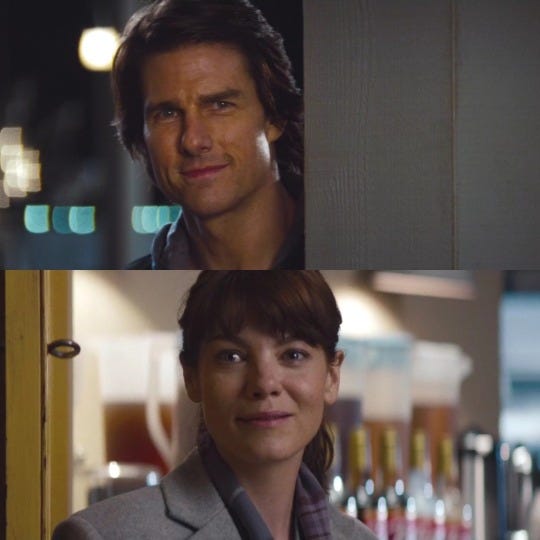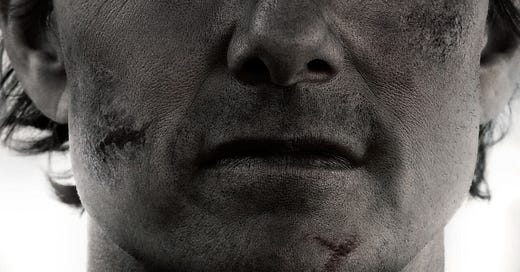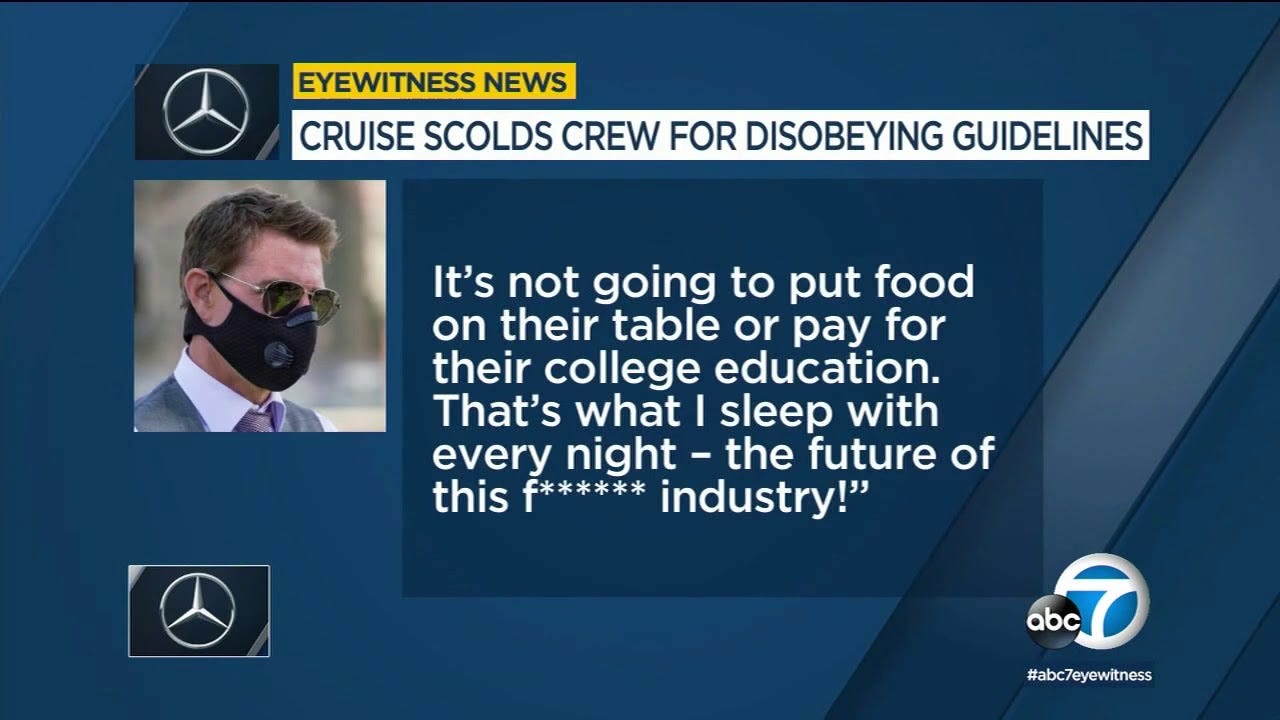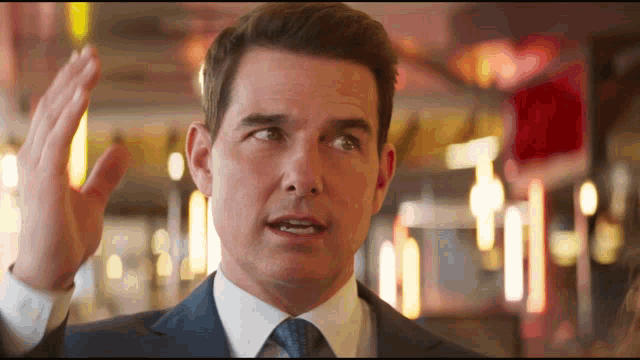Not unlike the final two movies of the Mission: Impossible franchise, my Tom Cruise essay wound up breaking itself into two parts. Part Two will be out in a few days, but this essay demanded to go first.
During brunch with the group chat last August, one friend got a news alert that some random man was climbing the Eiffel Tower. My immediate and sincere reaction: “Is it Tom Cruise?” I knew he was at the Olympics, gymnastics fan that he is; and climbing the Eiffel Tower just seemed like some Tom Cruise shit to do. That boy sure loves hanging off the side of things.
Cut to the Olympics closing ceremonies, and there is Tom Cruise, swinging above the Stade de France to accept the 2028 hosting responsibilities on behalf of Los Angeles before jumping onto his motorcycle, doing a HALO jump, and hanging off the Hollywood sign. Some real Tom Cruise shit to do.
There were some legitimate questions about why Tom Cruise should be the Los Angeles Olympics brand ambassador, most of which boiled down to: “him?” But this role perfectly fits the latest iteration of Tom Cruise, Action Star™️. He and his team have spent the last five years perfecting their singular message: Tom Cruise is the only man who can save Hollywood, and he’s willing to die to do it.
The “Tom Cruise Saves Cinema” narrative really started picking up during the lockdown era of COVID, when Tom was filming Mission: Impossible—Dead Reckoning Part 1. That summer, audio leaked of Tom screaming at members of the film crew for breaking COVID safety protocols. Listening to the audio itself, or even just reading the transcript, makes my jaw reflexively tense up. This tantrum is a massive power trip, directed at people sitting much lower in the food chain than he is, and fueled by an ego so massive it would break Freud’s brain.
It also runs totally perpendicular to what all of the cute morning show and late night anecdotes from Tom’s co-stars say about him—that he’s so generous, so open, such a genuinely nice guy. Instead, it fits with what former Scientologist celebs have shared about him—that he truly believes in his own superiority to other people and throws a fit when he’s treated otherwise.
But the PR narrative about this specific fit essentially took the “can ya blame him?” approach. Official and self-appointed spokespeople alike framed his tirade as a sign of his passionate commitment to both safety and the industry at large. According to them, his vigilance about COVID safety protocols is of a piece with his vigilance about safe stunt work—and we all love that stunt work, don’t we?
And the thing is, I do love that stunt work!1 Which is why the framing is so diabolically effective!
Tom’s commitment to Hollywood became a real runner2 for the next two years, as he refused to allow Paramount to release Top Gun: Maverick in any way other than a full international IMAX wide release. The vibe was that this movie would never be available to stream. It felt plausible that Tom would simply re-release it if anyone wanted to re-watch it. He recorded a video to play before each screening, thanking audiences for seeing his little movie the way it was meant to be seen, and for loving the movies just like he does (except he does it better, because he’s faster and stronger and hotter than you).
And the goodwill/promo tour that Tom has been on for this, the final3 Mission: Impossible movie, really has me reckoning (lol) with how effectively he has used the franchise to redirect people’s attention.
There was a time—call it 1996-2011—when Tom Cruise brought in a different director for every impossible mission. In the first, it was Brian DePalma and his Hitchcockian paranoia. In the second and worst, it was John Woo’s doves and doppelgängers. J. J. Abrams brought his lens flare and shaggy domesticity to number three, and Brad Bird brought his animated film background to the live-action cartoon that is Mission Impossible: Ghost Protocol.
There was also a time when Ethan Hunt had what some people would call a “personality.” In the first three movies, Ethan is cocky, nervy, and a bit prone to making mistakes. It’s fun to watch this fallible but remarkable human think his way out of impossible situations, because there’s the pretense of a chance that he might not make it out.
But that characterization wasn’t working for the people as much in 2006, when J.J. Abrams directed Mission: Impossible 3. In 2006, we were still living in the vivid aftermath of Tom Cruise jumping off Oprah’s couch to declare his love for Katie Holmes.4 We were also still less than a year out from Tom criticizing Brooke Shields on The Today Show for taking anti-depressants for her postpartum depression, and for melting down at Matt Lauer for questioning his tirade during the same interview.5 We suddenly knew way too much about Tom Cruise as a person, and we did not want to see him playing Ethan Hunt as a loving family man.
All that baggage brings us to Ghost Protocol. The third movie ends with Ethan choosing his honeymoon with Michelle Monaghan over going back to field work, but in the fourth, his wife is gone. For most of the movie, we believe that she’s been killed—a victim of Ethan’s notoriety as the only man who can save the world whenever another pointedly uncharismatic villain wants to bring the world to its knees with a blahblah once he gets the codes, or whatever. But we learn that Ethan benevolently helped his adorable Julia fake her death, so she could go back to a normal, non-Ethan-related life.

The nature of her departure is wrapped up in the new mythology of Ethan Hunt: that he is so supremely well-suited to save the world that he can’t let anyone get too close, lest they become a target for a hypothetical but definitely boring new villain. And that Ethan is so passionately committed to saving the world and every single person in it, that he is willing to sacrifice anything necessary, including himself, to do so.
This new version of Ethan is a total cypher, whose only personality traits are doggedness and loyalty. He no longer makes mistakes on his own, but is instead let down by his team’s technology and must use his preternatural physical ability to save the day. That is genuinely the operating principle of every showstopper set piece from here on out, from the outstanding Burj Khalifa scene in Ghost Protocol to the biplane scene in The Final Reckoning.
And, starting with the fifth (and my favourite) of the franchise, Tom stops swapping out directors and sticks with Christopher McQuarrie, who is better than anyone in the business at filming Tom doing stunts. We no longer come to this place for magic, but to see Tom Cruise throw himself around to entertain us, provided he’s divested himself of all quirks and idiosyncrasies.
The team behind the Mission: Impossible movies have been very transparent about the fact that McQuarrie and Cruise come up with the set pieces first, and then write a script around those set pieces. And the promo for these movies puts these scenes front and center, to the point that we get Making the Video-style clips of how they filmed The Big Stunt weeks before the movie has even come out. What they’ve been less transparent but just as obvious about is how the majority of the connective tissue between action scenes is just characters telling each other that Ethan is so awe-inspiring that the world has no choice but to bend to his will. It’s just iterations of Alec Baldwin calling him “the living manifestation of destiny” for two hours.
In this way, Ethan Hunt has become Tom's most effective PR shield. The conversation is no longer about Tom Cruise, weirdo Scientologist whose daughter allegedly will not speak to him. It’s about Tom Cruise, saviour of cinema who appears ready to die to entertain us.
Just as the plot of every Mission: Impossible movie now revolves around the messianic Ethan Hunt converting everyone to his worldview by being supernaturally awesome, so does the narrative surrounding the movies. Ethan Hunt’s devotion and sacrifice are one and the same with Tom’s. Tom Cruise has no public personality any more, just an affable but ineffable public persona. Like most magic tricks, it’s a feat of redirection that’s at least as impressive as it is sinister, because it’s been so damn effective.
I also love COVID safety protocols! Still do not love yelling at work.
I just caught this on my final read-through, and I promise it actually was unintentional 🫠
sure.
Katie Holmes in Teaching Mrs. Tingle is why I have a thing for brainy brunettes in Oxford shirts, so I almost get it.
History would kinda vindicate him on that last one.









It almost works on me every time I see Tom eat popcorn in that stupid way.. then I think, wait, hold on...
"Vivid aftermath" loooooool